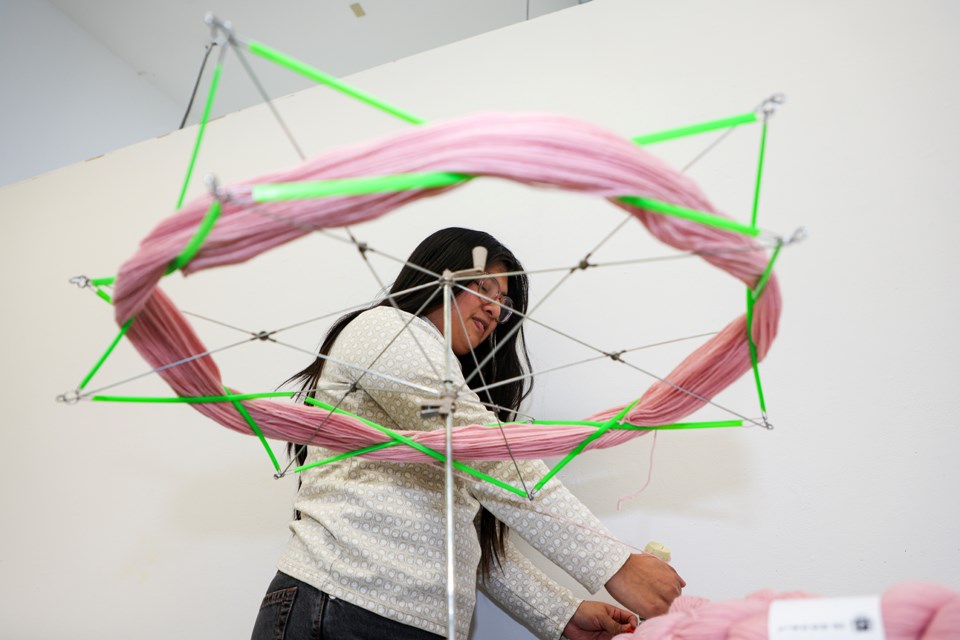BANFF – Valerie St. Pierre Smith sees your Converse shoes and raises you an Indigenized pair adorned with intricate beadwork and patterns.
The Indigenous Haute Couture – Digital Embellishments residency, a four-week program at the Banff Centre for Arts and Creativity, is empowering a diverse array of Indigenous makers and designers to infuse upcycling and digital technology with cultural heritage and traditional craftsmanship.
“To just see people living in a space that isn’t completely westernized – because I’ve been in predominantly white fashion spaces my whole life and it gets exhausting – is just like … I can’t even tell you how full it makes my heart,” said St. Pierre Smith, who is of Anishinaabe Gaa-waabaabiganikaag descent.
The residency welcomes eight textile-based artists of various Indigenous descents across Turtle Island, mostly from within Canada, but also the U.S., and one artist from Chile.
It integrates visual art techniques like laser cutting, 3D printing, silk screening, digital embroidery and casting into the design process, aiming to explore fashion’s role in addressing the climate crisis by incorporating innovative elements into designs.
It also explores more traditional Indigenous art forms like quillwork, beading and tufting.
St. Pierre Smith’s project is her take on contemporizing an early contact garment known as a strap dress, which was commonly worn by eastern woodlands Indigenous women, including those of Mi’kmaq, Ojibwe and Huron cultures.
“It’s an ensemble that women would traditionally wear and I’m coupling that with beadwork designs and stuff, but then I’m tweaking it so that the silhouette isn’t commodified because the strap dress is just really freaking cool … It’s kind of incorporating that new versus old,” she said.
Janine Windolph, director of Indigenous arts at the Banff Centre, said the Indigenous fashion residency started in 2019 and was born out of an idea to make space for Indigenous fashion designers to come together and be supported with studio access, wardrobe support and to build community.
“There’s limited, if not any programs, that are uniquely focused with the facilities we have here at the Banff Centre,” said Windolph. “We didn’t have a residency of this nature prior, so it’s also to fill a need to validate Indigenous fashion as an art form.
“What the artists are doing is they’re exploring the fashion industry. Their pieces are functional items that can be used in everyday wear, but also for the runway or special occasions. We’re building out to make more of the everyday wear so that we can participate in the larger fashion industry as active participants.”
Windolph noted a lot of Indigenous-derived garments seen on the runway prior, have been appropriated from Indigenous cultures by non-Indigenous designers. The residency aims to reclaim Indigenous voices and identities to become an authentic part of the larger fashion conversation.
“The fashion program is helping these designers get themselves opportunities to work on their project, to create networks, and often, like in the last program in 2022, we’ve seen them take these pieces to different stages like the runway to now be part of that community.”
Tashina Migwans-Odjig, who is also of Anishinaabe descent of the Council of Three Fires, Ojibwe, Odawa and Potawatomi, said she was inspired to join the residency because she’s unaware of any other programs like it.
She’s working on a Pendleton jacket as part of her project. A common garment to many Indigenous peoples, Migwans-Odjig’s piece is less straight cut and has more of a curved, detailed design fit for special occasions.
Unique to the garment is her late aunt’s logo, which will be printed onto the jacket. Her aunt, celebrated modernist painter Daphne Odjig, famously led the Indigenous Group of Seven, an early 20th century Euro-Canadian group of painters.
“A lot of my inspiration comes from her,” said Migwans-Odjig.
The Local Journalism Initiative is funded by the Government of Canada. The position covers Îyârhe (Stoney) Nakoda First Nation and Kananaskis Country.




